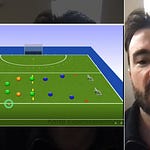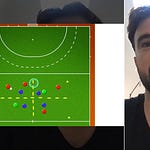What happens when you take real-game challenges and turn them into sharp, game-changing training sessions? If you joined us live for this workshop, you already know: A whole lot of practical insights, field-tested drills, and lively debate! If not—or if you want a recap—read on…
Meet Your Mastermind: Fede Tanuscio
By now, most of you know Fede—the Argentinian coach with European playing cred, a brain wired for solving tactical puzzles, and now Sports Director for the Luxembourg Federation. He’s no stranger to The Hockey Site crowd: regular contributor, creative drill architect, and a big believer in making training as relevant, efficient, and fun as possible.
For this session, Fede focused on how to bridge the ever-present gap between video analysis (“look at this men-to-men problem”) and pragmatic training sessions (“here’s how we practice breaking it down”).
Key Topics and Takeaways:
Real-World Problem: Building Up vs. Men-to-Men Defense
More teams are deploying men-to-men setups, especially in high-pressure moments. How do we avoid becoming static or isolated in our own half?
Shape as a Solution: Back Four vs. Back Five
Fede laid out how the choice between a back four and back five can open up more 2v1s on the flanks—a potential goldmine when beating personal marking. He prefers back four for early 2v1s and back five to exploit vertical channels, especially with overlapping midfielders.
Key Principles for Breaking Men-to-Men
Give-and-go, third-man play, overloads, post-ups, and playing to the free spaces (often with the aerial). The “drop and go” was a particular favorite—a tactic that’s popped up at the highest level lately.
Drills, Drills, Drills: Turning Theory Into Sweat
Every principle was matched with a progressive drill: warm-ups to hammer home give-and-go mechanics, positional exercises for third player involvement, small-sided battles with chokers for post-up practice, and live transition games with counter-pressing focus.
Don’t Sleep on the Long Corner
According to Fede, most sides under-invest in long corners, despite how often they come up and how quickly possession can turn into danger. His approach: practical long corner drills focusing on early forward options, deflections, creative overheads, and rapid post-up plays.
Top tip: The second player in the D is often the unsung hero for successful deflections!
Session Planning: Isolation or Game?
The interactive chat revealed a consensus—start with isolated technical elements, progress quickly to game-based scenarios. Passive defenders, variable-number overloads, and tailored constraints all got a mention.
Fun and Flow: How to Keep It Lively
A coach’s attitude is key: “We are like light bulbs! If you are at 40 watts, the players will be at 40. If you are at 90, they’re at 90!” Transitions, lots of scoring, and real competition make the work enjoyable and sticky.
Adapt to Resources
Not enough pitch space? No problem. Distill the tactical moment (even in quarter-pitch settings), emphasize roles, and chase quality at every level.
Final Game Play: Immediate Counter-Press
Fede emphasizes using main-to-main game moments to drill not just attacking, but immediate pressure upon losing the ball (“counter-press”). This replicates real match chaos—and more opportunities to win the ball higher up the pitch.
One Quote to Stick on Your Whiteboard:
“We are like light bulbs! If you operate at 40 watts, the players will be at 40. If you are at 90, they’re at 90!”
In Short… This was a masterclass in running a training session that mirrors match reality, gradually layering technical skills, tactical choices, and “why it matters” through game-based, energetic exercises. Whether you run elite squads or teach budding U16s, the rationale is the same: build context, insist on quality, and never lose the competitive fire—either in design or delivery.
Ready for More?
There’s much more gold in the full recording—video examples, whiteboard breakdowns, and real-time debate with experienced coaches from across the hockey globe. Missed the live? Want to mine it again for session ideas? Catch the full replay here ↑ or read on for more of a deep dive ↓













